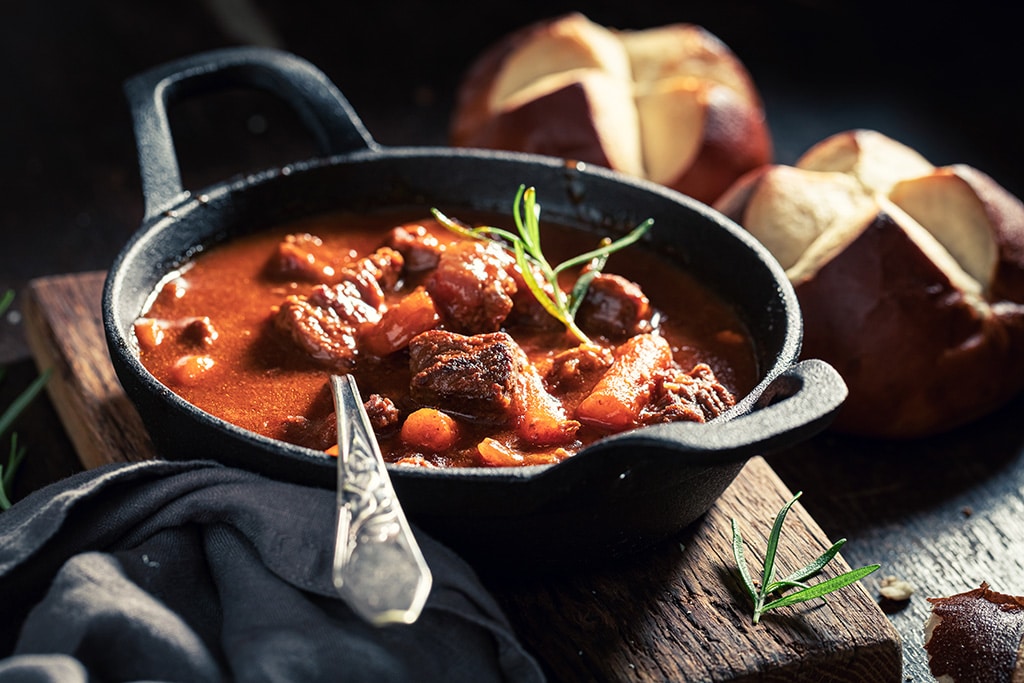
Let’s step back in time, shall we? To a Hungary of yesteryears, where goulash soup was more than just a meal; it was a testament to the resilience and resourcefulness of the Hungarian people.
The origins of goulash soup can be traced back to the 9th century, when Hungarian shepherds roamed the vast plains, known as the Puszta. Picture this: these hardy souls, tending to their flocks under the open sky, needed a meal that was hearty, nourishing, and easy to prepare. And so, the earliest versions of goulash were born.
Goulash began as a simple shepherd’s stew. Imagine those shepherds, gathered around a crackling campfire, using the most basic of ingredients. Chunks of meat, typically beef or sometimes pork, were combined with onions and seasoned with the limited herbs and spices available. The secret, of course, was paprika – even back then, this vibrant spice added depth and flavor to their humble meal.
As Hungary evolved, so did goulash soup. It gradually moved from the open flame to the kitchens of homes and restaurants. The dish became more refined, with the addition of vegetables like potatoes, carrots, and bell peppers. Yet, at its core, it remained a comforting, hearty stew that warmed the body and soul.
Today, goulash soup holds a special place in Hungarian culture. It’s not just a dish; it’s a symbol of Hungary’s history, strength, and endurance. It’s a reminder of a time when resourcefulness was key, and a simple pot of simmering stew could sustain you through long journeys and harsh winters.
Every Hungarian family has its own version of goulash soup, and recipes are often passed down through generations. Each family’s recipe is like a treasure, guarded and cherished. The variations are endless – some like it spicy, others prefer it mild; some make it thick, while others prefer a thinner broth. It’s a dish that reflects the unique tastes and traditions of each family.
While goulash soup is undeniably Hungarian, its fame has spread far beyond Hungary’s borders. It’s a dish that has captured the hearts (and taste buds) of people worldwide.
Goulash was considered a “national dish” of Hungary, and its preparation was governed by strict rules.
In the late 19th and early 20th centuries, Hungary’s Academy of Sciences defined goulash as a specific culinary creation. According to these rules, authentic Hungarian goulash should be made with chunks of beef, seasoned with paprika, and cooked with onions and peppers. Any variation that deviated from these guidelines was not considered true goulash.
The standardization helped preserve the traditional recipe and cultural significance of goulash in Hungary. While today there are many variations of goulash, it’s still appreciated for its deep cultural roots and the role it played in shaping Hungary’s culinary identity.
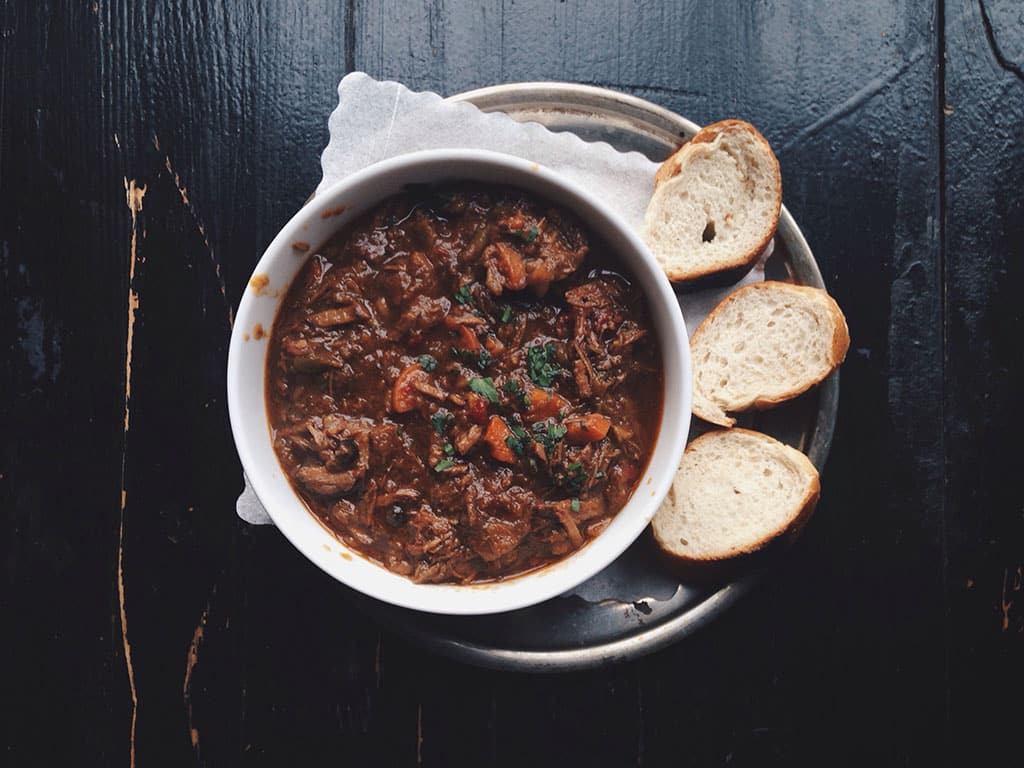
Now, let’s delve into the heart of what makes goulash soup a true delight for the senses – its ingredients. Imagine a symphony of flavors and textures, each ingredient playing its part to create a harmonious and satisfying culinary experience.
At the core of goulash soup is the meat. Traditionally, it’s beef, and it’s typically a tougher cut. Why, you ask? Well, the slow process turns this meat into tender, melt-in-your-mouth goodness. Picture chunks of beef, patiently cooking in a savory broth until they practically fall apart on your spoon. It’s the kind of meat that has absorbed all the flavors of the soup, creating a rich base.
Every good soup begins with onions, and goulash is no exception. They’re sautéed until they turn soft and golden, releasing their sweet aroma. These humble bulbs provide a subtle sweetness that balances the richness of the meat and the intensity of the spices.
Ah, the star of the show – paprika! It’s not just an ingredient; it’s the soul of goulash soup. Paprika is what gives the soup its signature deep red hue and its unmistakable, slightly smoky flavor. Hungarians take their paprika seriously, and you’ll find various types, from mild to hot, depending on your preference. This spice is what transforms the stew into a Hungarian masterpiece.
Ripe, juicy tomatoes add a touch of acidity and sweetness to the soup. They brighten up the flavors and complement the richness of the meat and paprika. Whether fresh or canned, tomatoes are a key ingredient in achieving that perfect balance in every spoonful.
To create that comforting thickness in goulash soup, you need potatoes. They soak up the flavors of the broth and become tender, adding to the dish. It’s like a warm, cozy hug in every bite.
Colorful bell peppers, often red or green, bring a burst of freshness and a hint of sweetness to the soup. They not only add flavor but also a delightful visual contrast, making the dish as beautiful as it is delicious.
Carrots contribute a sweetness and earthiness to the soup. They also add a pop of orange color, making each bowl a work of art. Imagine biting into a tender carrot, infused with the flavors of the broth – it’s a delightful experience.
What’s a soup without garlic? It provides a gentle kick of pungency, enhancing the overall flavor profile. Whether minced or sliced, garlic cloves play a vital role in making each spoonful memorable.
The foundation of any good soup is its broth. In goulash soup, it’s typically a beef or vegetable broth. This liquid gold is what unites all the ingredients, creating a cohesive and flavorful soup.
Beyond paprika, goulash soup may include a mix of spices like caraway seeds, bay leaves, and thyme. These spices add depth and complexity to the flavors, creating a well-rounded taste experience.


Goulash soup is not just a recipe; it’s a tradition. Imagine yourself in a cozy Hungarian kitchen, surrounded by the aroma of paprika and simmering meat, as you prepare to create a pot of goulash soup that will warm your soul.
It all begins with the meat. What you want to do is start by searing the beef in a hot, oiled pot. This step is crucial because it locks in the juices and flavors, creating a foundation for your soup. As you sear the meat, the sizzling sound and the intoxicating aroma fill the kitchen.
After searing the meat, you set it aside and turn your attention to those sautéed onions we mentioned earlier. You place them into the same pot where the meat was cooked, allowing them to soak up all the meaty goodness. You then add the paprika, that star ingredient, to the onions, creating a paste that infuses the entire dish with its flavor and color. At this point, the warm, smoky scent of paprika envelops your kitchen.
Ripe, juicy tomatoes come next. You dice them and introduce them to the pot, releasing their sweet and slightly tangy essence. As they mingle with the paprika and onions, the mixture transforms into a red base that promises a burst of flavor in every spoonful.
Now, it’s time to reunite the beef with this flavor-rich base. You add the beef back to the pot. The broth is poured over this ensemble, and then, the waiting game begins. Goulash soup is a patient dish. It simmers slowly, allowing the meat to tenderize, the flavors to meld, and the magic to happen. The scent in your kitchen becomes more enticing with each passing minute.
As the soup boils away, you prepare the root vegetables – potatoes, carrots, and bell peppers. They have been chopped into bite-sized pieces, ready to join the party. These veggies add layers of flavor and a satisfying richness to the soup.
Goulash soup is known for its slightly thick consistency, thanks to the starchy potatoes and the patience of the cook. To achieve this, you crush some of the potatoes against the pot’s side, releasing their natural starches. Then, you season the soup with garlic, spices like caraway seeds, bay leaves, and thyme, and a touch of salt and pepper. Each addition is like a brushstroke on a canvas, contributing to the overall masterpiece.
Finally, as the soup nears completion, you add those sweet bell peppers, infusing the dish with their vibrant colors and crispness. You stir the soup, and the melody of simmering vegetables and spices fills your kitchen. You know it’s ready when the meat becomes tender, the flavors achieve perfect balance, and the irresistible scent envelops you.
As you fill bowls with goulash soup, you can’t help but appreciate the effort that went into this culinary creation. Each spoonful tells a story of tradition, patience, and the artistry of Hungarian cuisine. It’s a moment to savor, a moment to share with loved ones, and a moment that transports you to the heart of Hungary, where every bowl of goulash soup is a celebration of flavor and culture.
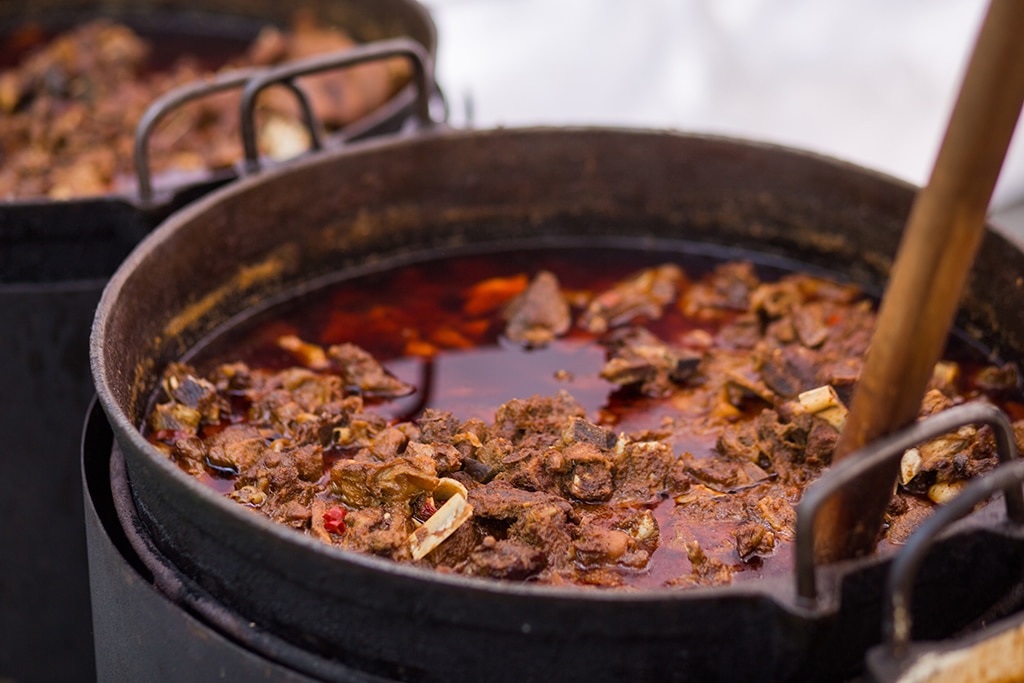
Beyond its taste and aromatic pull, goulash soup holds a cultural significance in Hungary. It’s not just a dish; it’s a symbol of tradition, heritage, and community.
Goulash soup is often referred to as the “soul food” of Hungary. Its roots trace back centuries to the time of Hungarian shepherds, who roamed the vast Hungarian plains with their cattle. The dish was born out of necessity and ingenuity. Meat was abundant, and paprika, introduced to Hungary by the Turks, added the flavor that would become synonymous with Hungarian cuisine.
Preparing goulash soup is a culinary art form in Hungary. It’s a dish that transcends generations, with each family having its own cherished recipe. Passed down from grandmothers to mothers to daughters and sons, these recipes are a living testament to the country’s culinary heritage. Imagine being in a Hungarian kitchen, watching as the secrets of goulash soup are shared across generations – a ritual that connects the past with the present.
You often prepare goulash soup in large quantities, making it perfect for gatherings and celebrations. Picture yourself at a Hungarian festival, where the aroma of goulash soup wafts through the air. It’s a dish that brings people together, fostering a sense of togetherness and unity. At such gatherings, you’re not just enjoying a meal; you’re participating in a shared cultural experience.
For Hungarians, goulash soup is a source of national pride. It’s a dish that embodies the country’s agricultural heritage, with its hearty ingredients and robust flavors. It’s a testament to the resilience and resourcefulness of the Hungarian people throughout history. Having a bowl of goulash soup is like paying homage to the resilience of a nation.
While goulash soup is undeniably Hungarian, its popularity has transcended borders. It’s a dish that’s celebrated in neighboring countries like Austria, Slovakia, and the Czech Republic, each adding its own twist to the recipe.
In Hungary, goulash soup isn’t reserved for special occasions alone. It’s a comfort food, a daily delight that warms both body and soul.
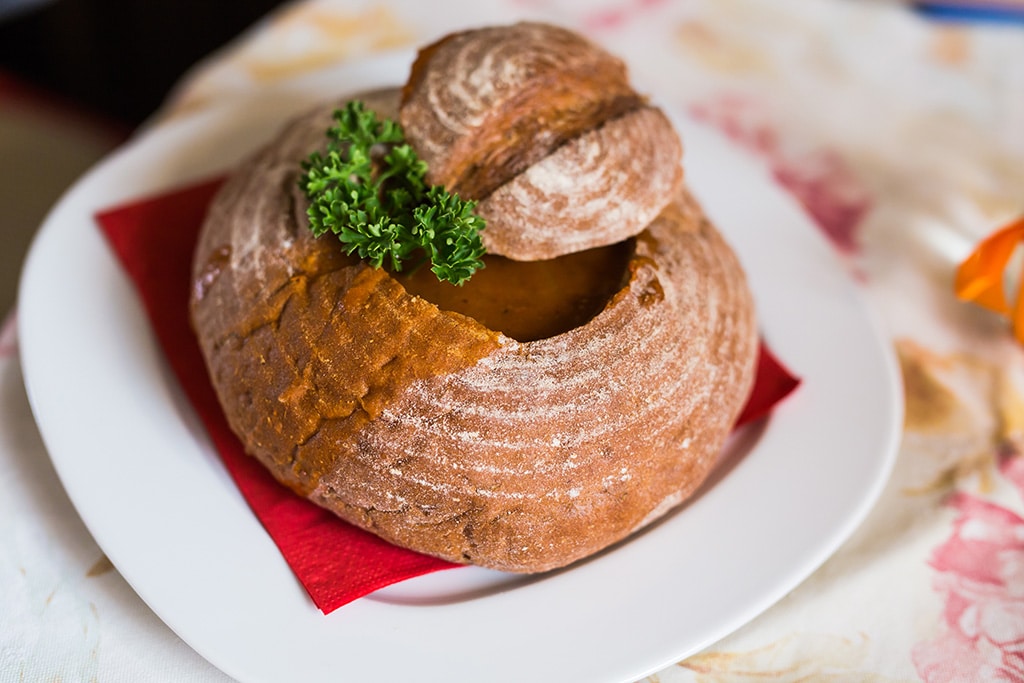
Now, let’s delve into the remarkable versatility of goulash soup. It’s a dish that adapts to various tastes, preferences, and dietary needs, making it a favorite for all occasions. Imagine a table set for a family dinner, where each member enjoys their own personalized bowl of Hungarian food.
Goulash soup is like a blank canvas for culinary creativity. While the classic version features tender beef, paprika, and a medley of vegetables, it’s incredibly adaptable.
For those who prefer a plant-based diet, goulash soup doesn’t disappoint. Imagine being in a cozy vegetarian restaurant in Budapest, where a steaming bowl of goulash soup arrives at your table, brimming with vegetables, beans, and tofu or tempeh as a meat substitute. The rich paprika-infused broth remains the star, creating a vegetarian masterpiece that’s both satisfying and flavorful. For vegans, simply omit the dairy toppings, and you have a delightful vegan goulash soup.
Goulash soup is open to international influences. Imagine traveling to Hungary and sampling a goulash soup fusion, where it’s combined with elements from other cuisines. In Budapest, you might find goulash soup with a French twist, featuring a crusty baguette and melted cheese. In a trendy eatery, it could be presented as goulash soup with an Asian flair, infused with lemongrass and coconut milk. It’s a dish that embraces global inspiration while maintaining its Hungarian core.
Goulash soup can be a hearty, filling meal on its own or a light and flavorful appetizer. Imagine sitting at a traditional Hungarian restaurant, where goulash soup is served in small portions as an appetizer, teasing your taste buds before the main course. Alternatively, picture yourself in a countryside inn, where a generous bowl of goulash soup, accompanied by crusty bread, serves as a satisfying, rustic meal. It’s a dish that effortlessly transitions from starter to main course.
Leftover Hungarian food is a culinary treasure. Imagine being in a Hungarian home, where the remnants of yesterday’s goulash soup are transformed into a new delight. It might become a filling stew with the addition of beans and fresh herbs, or it could be thickened to create a flavorful sauce for pasta or rice. It’s a testament to the resourcefulness and creativity of Hungarian home cooks.
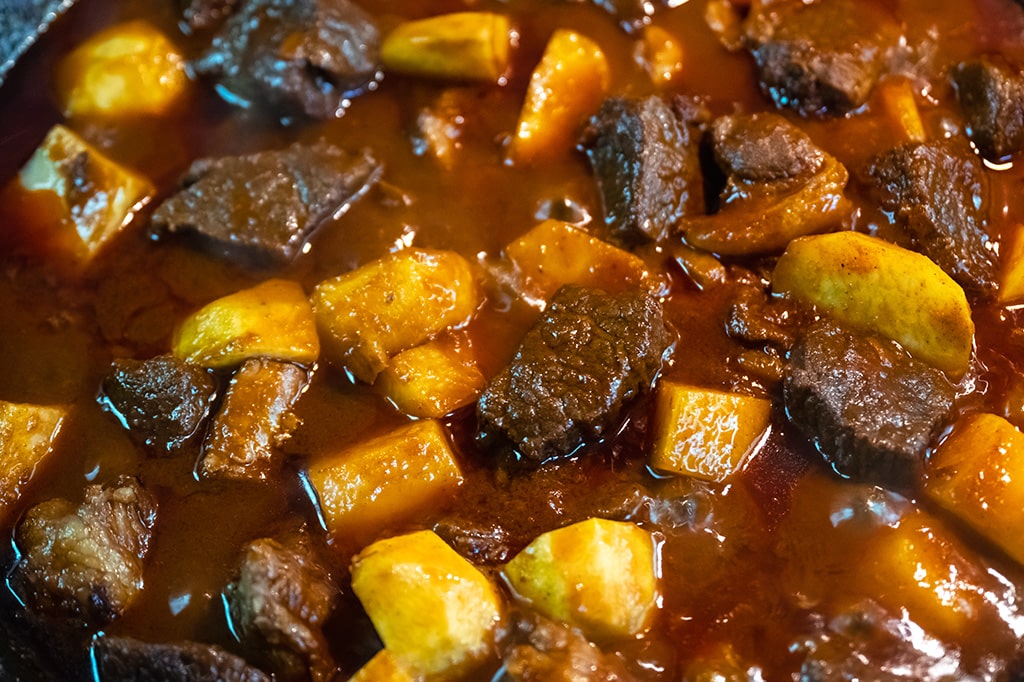
Now, let’s transport ourselves to a cozy Hungarian eatery where the aroma of goulash soup fills the air, and locals and tourists alike gather to savor this beloved dish. It’s not just a meal; it’s a moment of culinary heaven!
Imagine sitting at a wooden table in a quaint Hungarian village, where goulash soup is a family tradition. Generation to generation is how people usually pass down the recipes. The act of preparing and sharing goulash soup is like a cultural heirloom, with each family adding its unique touch. As you take that first spoonful, you’re not just tasting a meal; you’re savoring the rich history and heritage of Hungarian cuisine.
Traveling to Hungary and enjoying goulash soup in its place of origin is a journey into the heart of Hungarian culture. In Budapest, you might visit a bustling market, where food vendors serve steaming bowls of goulash soup to locals and tourists alike. The vibrant atmosphere, the sound of chatter in Hungarian, and the flavors of the soup create an unforgettable experience. It’s a taste of Hungary that lingers in your memory long after you’ve left.
Hungarian winters are known for their cold and crisp evenings. Picture yourself in a cozy Budapest café on a chilly night, your hands wrapped around a warm bowl of goulash soup. The rich, steaming broth warms you from the inside out, and the aroma of paprika infuses the air.
Hungarian celebrations are often accompanied by goulash soup. Imagine being at a lively Budapest festival, where street vendors serve this iconic dish to revelers. The lively music, colorful decorations, and laughter in the air create a festive atmosphere. Enjoying goulash soup amidst the festivities is a joyous experience, a celebration of both food and life.
In a world of fast food and rushed meals, goulash soup represents the slow food movement at its finest. Picture yourself at a traditional Hungarian restaurant, where the chef takes great pride in slow-cooking the soup to perfection.
Goulash soup also has a remarkable ability to bring people together. Imagine a long wooden table in a Hungarian countryside inn, where locals and tourists sit side by side, enjoying this communal meal. Conversations flow freely, and friendships are forged over shared bowls of soup. It’s a reminder that food has the power to unite strangers and create a sense of belonging.
In summary, goulash soup is not just about satisfying your hunger; it’s about immersing yourself in the rich culture, tradition, and culinary delight of Hungary. It’s a moment to appreciate the flavors, the history, and the connections it brings. So, whether you’re enjoying it in Hungary itself or at your kitchen table, take a moment to savor the magic of goulash soup. Let it transport you to a place where food is a celebration!

Copyright © 2024 by EuroFoodExpress.com. All rights reserved.